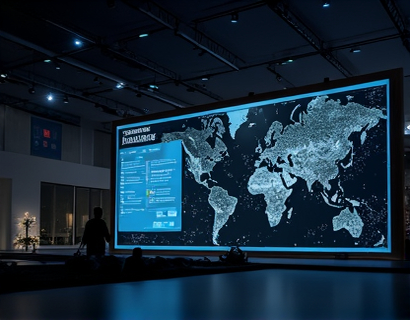Next-Gen QR Code Technology: Elevating Business Engagement and Social Media Interaction for Modern Enterprises
In the rapidly evolving digital landscape, businesses and social media managers are constantly seeking innovative solutions to enhance engagement and interaction. One such technology that has emerged as a game-changer is next-generation QR code technology. This advanced form of QR codes is not just an improvement over the traditional version but a transformative tool that can significantly elevate how brands connect with their audience. This article delves into the features, benefits, and practical applications of next-gen QR codes, providing insights for businesses and social media managers looking to stay ahead in the digital game.
Understanding Next-Gen QR Codes
Next-gen QR codes, often referred to as enhanced or intelligent QR codes, represent a significant leap forward from their predecessors. These codes are designed with modern digital needs in mind, offering a range of features that make them more versatile, secure, and user-friendly. Unlike traditional QR codes which primarily store static information, next-gen QR codes can dynamically generate and update content, integrate with various platforms, and provide a richer user experience.
The technology behind next-gen QR codes includes advanced encoding methods, improved error correction, and support for multiple data types. This means that these codes can store not just URLs and text but also images, videos, and even complex data sets. The enhanced error correction capabilities ensure that the information remains readable even if the code is partially damaged, making them more robust and reliable in real-world scenarios.
Customization and Personalization
One of the most compelling features of next-gen QR codes is their customization potential. Brands can tailor these codes to match their branding, making them visually appealing and memorable. Customizable colors, shapes, and logos allow businesses to integrate QR codes seamlessly into their marketing materials, packaging, and physical store environments. This level of personalization not only enhances the aesthetic appeal but also reinforces brand identity, making the interaction more meaningful for the consumer.
Moreover, the customization extends to the functionality of the QR code. Businesses can set up different actions based on the context in which the code is scanned. For instance, a QR code on a product package could direct the user to a specific product page on the company’s website, while a QR code at a trade show booth could lead to a landing page with event details and registration forms. This context-aware approach ensures that the user experience is relevant and engaging.
Enhanced User Experience
The user experience is a critical factor in the success of any digital tool, and next-gen QR codes excel in this area. The integration of QR codes with mobile applications and web platforms provides a smooth and intuitive interaction. When a user scans a next-gen QR code, they are often redirected to a optimized landing page designed for mobile devices, ensuring fast load times and a seamless experience. This is particularly important given the increasing use of smartphones for online activities.
Additionally, next-gen QR codes can be linked to interactive content such as augmented reality (AR) experiences. By scanning a QR code, users can unlock AR content that enhances their understanding of a product or service. For example, a furniture retailer could use QR codes to allow customers to see how a piece of furniture would look in their home before making a purchase. This immersive experience not only engages the customer but also reduces return rates by providing a more accurate preview of the product.
Boosting Social Media Interaction
Social media platforms are a crucial channel for businesses to engage with their audience, and next-gen QR codes can significantly enhance this interaction. By placing QR codes on social media posts, businesses can drive traffic to their websites, increase engagement, and gather valuable data. For instance, a QR code shared on a Facebook post can lead to a dedicated landing page where users can sign up for a newsletter, participate in a contest, or access exclusive content.
Next-gen QR codes can also be used to create interactive social media campaigns. For example, a brand could launch a scavenger hunt where participants need to scan QR codes placed in different locations to unlock clues and win prizes. This type of engagement not only increases brand visibility but also fosters a sense of community among followers.
Improving Customer Interaction
Customer interaction is a key area where next-gen QR codes can make a significant impact. In retail environments, QR codes can be used to provide instant access to product information, customer reviews, and usage instructions. This immediate availability of information helps customers make informed decisions, leading to higher satisfaction and loyalty. Moreover, QR codes can be used to collect customer feedback directly at the point of interaction, providing businesses with valuable insights to improve their offerings.
In the service industry, QR codes can streamline the customer service process. For example, a QR code displayed on a service receipt can direct the customer to a page where they can submit feedback, request support, or access FAQs. This not only simplifies the process for the customer but also reduces the workload on customer service teams by providing a self-service option.
Enhancing Security and Trust
Security is a paramount concern in the digital age, and next-gen QR codes address this by incorporating advanced security features. These codes can include encryption and authentication mechanisms to ensure that the information they direct users to is safe and trustworthy. This is particularly important for businesses that handle sensitive data or transactions.
By using secure QR codes, businesses can build trust with their customers. When users scan a QR code and know that the link is secure, they are more likely to engage with the content and share their positive experience with others. This trust factor can be a significant differentiator in a market where security breaches are a common concern.
Data Collection and Analytics
Next-gen QR codes offer powerful data collection and analytics capabilities. Businesses can track the number of scans, the location of scans, and the actions taken after scanning. This data can be invaluable for understanding customer behavior, optimizing marketing strategies, and measuring the effectiveness of campaigns. For instance, a retailer can use QR code analytics to identify which products are generating the most interest and adjust their inventory and promotions accordingly.
Moreover, the data collected can help in creating more personalized marketing efforts. By analyzing scan patterns and user interactions, businesses can segment their audience and tailor their messages to specific groups, leading to higher engagement and conversion rates.
Case Studies and Real-World Applications
To better understand the practical benefits of next-gen QR codes, let’s look at a few real-world applications across different industries.
In the hospitality sector, a luxury hotel chain implemented next-gen QR codes on room keys and welcome packets. Guests could scan the code to access a digital concierge service, view local attractions, and even make restaurant reservations. This not only enhanced the guest experience but also reduced the need for physical materials, aligning with the hotel’s sustainability goals.
In the education sector, a university used QR codes on campus maps to provide students and visitors with interactive information about facilities, events, and resources. The QR codes linked to a mobile app that offered a guided tour, further enriching the campus experience.
In the healthcare industry, a clinic used QR codes on patient records to streamline the check-in process. Patients could scan a code to access their appointment details, view test results, and even schedule follow-up visits. This not only improved efficiency but also reduced the risk of miscommunication.
Challenges and Considerations
While next-gen QR codes offer numerous benefits, there are also challenges and considerations that businesses should be aware of. One of the primary challenges is ensuring compatibility across different devices and platforms. Not all QR code readers may support the advanced features of next-gen codes, so it’s essential to test and validate the codes across a range of devices.
Another consideration is the initial setup and integration cost. Implementing next-gen QR codes may require investment in new technology and training for staff. However, the long-term benefits in terms of enhanced engagement and operational efficiency often outweigh these initial costs.
Privacy is also a critical concern. Businesses must ensure that any data collected through QR codes is handled in compliance with data protection regulations. Transparency about how data is used and providing options for users to opt-out can help maintain trust and compliance.
Conclusion
Next-gen QR code technology represents a significant advancement in digital engagement tools for modern enterprises. By offering customizable, secure, and interactive experiences, these codes can help businesses enhance their digital presence, improve customer interaction, and drive meaningful engagement on social media. As the digital landscape continues to evolve, embracing next-gen QR codes can provide a competitive edge and foster deeper connections with the audience.










































